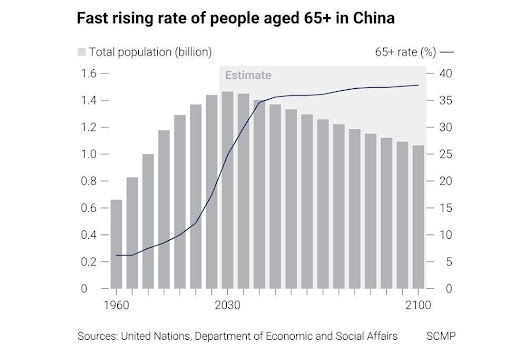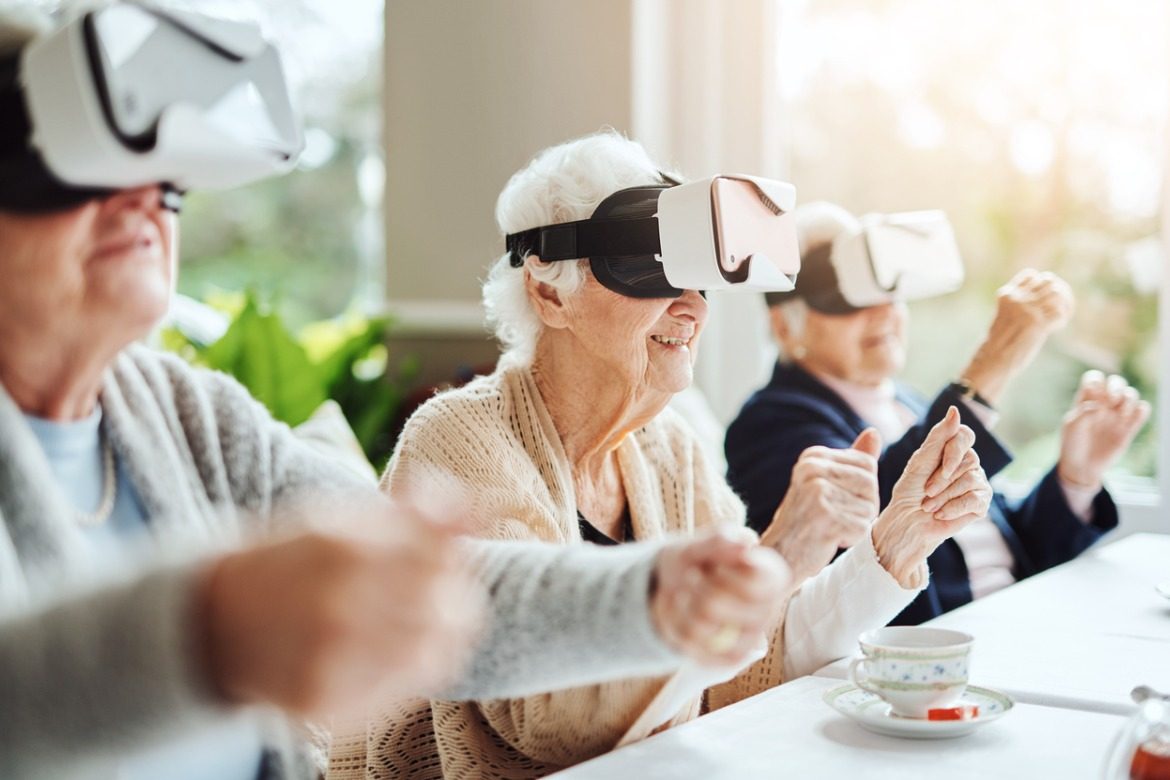- China’s elderly population is expected to increase significantly over the coming decades, thereby presenting the country with an unprecedented set of challenges and opportunities.
- In this context, China’s leadership has increasingly turned to remote health monitoring systems and assistive technologies, which have greatly benefited from the proliferation of 5G networks and advances in AI.
Due in large part to the continuously rising life expectancies and ever-declining fertility rates, China’s elderly population is expected to increase significantly over the coming decades. This, in turn, presents the country with an unprecedented set of challenges and opportunities – particularly when it comes to elderly care.
According to the World Health Organization (WHO), China’s population of people aged 60 and over is estimated to surpass 402 million people – 28% of the total population – by 2040. Moreover, many of these individuals will likely be affected by chronic non-communicable diseases, such as cardiovascular diseases or diabetes. This implies that a significant proportion of China’s graying population will presumably require regular assistance for their daily living and health needs, thereby exacerbating the anticipated shortage of health and elderly care workers.

Figure 1 Sito/South China Morning Post (SCMP), 2021
In order to address these challenges, China’s leadership has therefore increasingly turned to remote health monitoring systems and assistive technologies to fulfill two main goals. The first is to reduce the strain on its institutional elderly care facilities. The second is to provide widespread access to an extensive range of affordable healthcare and social services – ideally from the comfort of one’s own home.
Smart homes & related technologies
To achieve this, much attention has been devoted to exploiting a concept known as the Internet-of Things (IoT), which, in the context of elderly care, is widely seen to be the key to the development of so-called “smart homes”.
Smart homes primarily consist of a host of compact sensors, which can be embedded into a traditional house – including in the form of intelligent furniture or smart textiles – and coupled with advanced communication technologies to “facilitate remote and automatic monitoring of [the] home environment, security and overall health status of the occupants” (Majumder et al., 2017). Moreover, by using artificial intelligence (AI), smart home platforms can also “learn” the normal behavioral and physiological patterns of their inhabitants, as well as immediately notify emergency services in the event that any anomalies are detected. Finally, smart homes can also make use of a wide range of assistive robots to support senior citizens in their daily activities and to reduce isolation. Taken together, these technologies, therefore, constitute a promising solution to facilitate widespread “aging in place”.
Policy-driven support
Recognising the significant potential of these emerging technologies, the Chinese government introduced a number of policies in the past years to help expedite the development of promising tech-based innovations for elderly care. These, for example, include the Notice on Comprehensive Reform Pilot of Elderly Care Service Industry, Several Opinions on Speeding up the Development of Elderly Care Service Industry, the 13th Five-year Plan for Healthy Aging (2016–2020), and the Medium- and Long-Term Plan for Proactively Responding to Population Aging, to name a few.
Chinese policymakers also introduced several plans that addressed more specific segments within elderly care, such as the country’s first specialised national policy on smart homes – the so-called Action Plan for the Development of Smart Health and Elderly Care Services (2017–2020), as well as the State Council’s Opinions on Accelerating the Development of the Industry of Rehabilitation Aid. The latter is arguably one of the most important documents in this context, and, in particular, asserted that the industrial scale of the rehabilitation and assistive products industry shall surpass RMB 700 billion (USD 103.3 billion) by 2020. It also put forward a series of goals to create an ecosystem for assistive technology development, such as the launch of two batches of National Comprehensive Innovation Pilot Projects for the Rehabilitation Assistive Device Industry.
The role of 5G and AI
In addition to the aforementioned policy-driven support, China’s large-scale deployment of 5G networks presents another key driver to transform elderly care in general, and healthcare-related aspects in particular. This is because although the promising potential of telemedicine has captivated the attention of Chinese researchers for decades, its development has largely been constrained due to inadequate communications technologies. However, thanks to their lower latency, higher capacity, and increased bandwidth, 5G networks promise to be able to overcome many of these “legacy connectivity problems,” as explained by Qingjun Lu, Director of Development at the China-Japan Friendship Hospital and the National Telemedicine and Connected Health Center.
This is vital because modern healthcare systems generate a tremendous amount of data that needs to be analysed, interpreted, and monitored – an arduous and time-consuming task, which is relatively error-prone when conducted by clinicians, due to visual fatigue. This is where AI systems are particularly useful, as they excel at extracting information in an accurate, timely and reliable manner, and can identify features that would escape the human eye. 5G networks in turn complement these features by being able to support the “precise, real-time transmission of massive [amounts of] data” (Lan, n.d.) via cloud platforms.
On an individual level, this implies that elderly patients who are no longer able to easily travel can nevertheless access high-quality medical resources, regardless of where they are. This could also help to reduce their exposure to contagions, which is especially relevant in the context of the ongoing coronavirus pandemic. On a more general level, 5G has the potential to help small, rural healthcare providers connect with bigger hospitals and make use of their AI applications, as well as to benefit from their skilled specialists. In doing so, efficient collaborations between urban and rural hospitals can be facilitated, and access to advanced diagnosis and treatment options can be improved.
Conclusion and Outlook
As China’s rapidly aging population continues to increasingly stretch the country’s health and social systems to their limits, tech-based platforms and services have emerged as promising candidates to help revolutionise the elderly care industry and enable senior citizens to live happy, healthy lives at home. This is reflected in the considerable backing given by a series of policies and government-driven initiatives, which, for example, include several pilot programs for smart homes and the rehabilitation assistive device industry. In addition, the private sector has also been actively ramping up its activities to cater to the booming elderly care market, which is expected to surpass RMB 10 trillion (USD 1.57 trillion) by 2024.
Despite this progress, it is important to note that several challenges must still be addressed before genuine smart home-based care becomes widespread. These, in particular, include reducing the cost of the various technologies, increasing the elderly’s acceptance to them, and addressing the incompatibility that currently exists between various products and services.
(Editor’s Note: To read some more stories on elderly care robotics featured on Swissnex in China website click 1. Next Step, a Care Robot 2. The Next Niche Market – Elderly Care Robotics in China)
References
BRESNICK, Jennifer. Top 12 Ways Artificial Intelligence Will Impact Healthcare [online]. 30.04.2018. https://healthitanalytics.com/news/top-12-ways-artificial-intelligence-will-impact-healthcare (accessed on 09.08.2021).
CHEN, Liang-Kung. “Gerontechnology and artificial intelligence: Better care for older people.” Archives of Gerontology and Geriatrics, 2020, 91, pp 1-2. Available at: https://www.ncbi.nlm.nih.gov/pmc/articles/PMC7482590/.
Intel. Benefits of 5G Technology: 5g Features and Advantages [online]. [n.d.]. https://www.intel.com/content/www/us/en/wireless-network/5g-benefits-features.html (accessed on 09.08.2021).
LAN, Xusheng. Transforming Healthcare with 5G [online]. [n.d.]. https://www.huawei.com/en/technology-insights/publications/winwin/38/transforming-healthcare-5g (accessed on 09.08.2021).
MADAKAM, Somayya, RAMASWAMY, R., and TRIPATHI, Siddharth. “Internet of Things (IoT): A Literature Review”. Journal of Computer and Communications, 2015, 3, pp. 164-173; Majumder et al., 2017.
MAJUMDER, Sumit, AGHAYI, Emad, NOFERESTI, Moein, MEMARZADEH-TEHRAN, Hamidreza, MONDAL, Tapas, PANG, Zhibo and DEEN M. Jamal. “Smart Homes for Elderly Healthcare—Recent Advances and Research Challenges”. Sensors, 2017, 17(11), 2496. Available at: https://www.ncbi.nlm.nih.gov/pmc/articles/PMC5712846/.
SITO, Peggy. China’s ageing society: tech platforms step in with array of health care services to assist greying population [online]. 24.07.2021. https://www.scmp.com/business/companies/article/3142066/chinas-ageing-society-tech-platforms-step-array-health-care (accessed on 09.08.2021).
Teller Report. The second batch of national comprehensive innovation pilot projects for the rehabilitation assistive device industry started [online]. 18.01.2021. https://www.tellerreport.com/news/2021-01-18-%0A—the-second-batch-of-national-comprehensive-innovation-pilot-projects-for-the-rehabilitation-assistive-device-industry-started%0A–.S1ViQkjMJ_.html (accessed on 09.08.2021).
The State Council of the People’s Republic of China (State Council). China to promote rehabilitation and assistive products industry Populations [online]. 27.10.2016. http://english.www.gov.cn/policies/latest_releases/2016/10/27/content_281475476503586.htm (accessed on 09.08.2021);Yu, 2021.
THOMAS, Shane A., QIU, Zeqi, CHAPMAN, Anna, LIU, Shuo 5 and BROWNING,
Colette J. “Editorial: Chronic Illness and Ageing in China”. Frontiers in Public Health, 2020, 8(104), pp. 1-2. Available at : https://www.frontiersin.org/articles/10.3389/fpubh.2020.00104/full.
World Health Organization (WHO). Ageing and health in China [online]. [n.d.]. https://www.who.int/china/health-topics/ageing (accessed on 09.08.2021).
World Health Organization (WHO). WHO Global Forum on Innovations for Ageing Populations [online]. 12.12.2013. https://extranet.who.int/kobe_centre/sites/default/files/GFIAP_report_0.pdf (accessed on 09.08.2021).
YU, Hongliu in: World Intellectual Property Organization (WIPO). WIPO Technology Trends 2021: Assistive technology, 2021, p. 169. Available at: https://www.wipo.int/publications/en/details.jsp?id=4541.
ZHANG, Quan, LI, Meiyu and WU, Yijin. “Smart home for elderly care: development and challenges in China”. BMC Geriatrics, 2020, 20(318), pp. 1-8; Majumder et al., 2017. Available at: https://bmcgeriatr.biomedcentral.com/articles/10.1186/s12877-020-01737-y.


